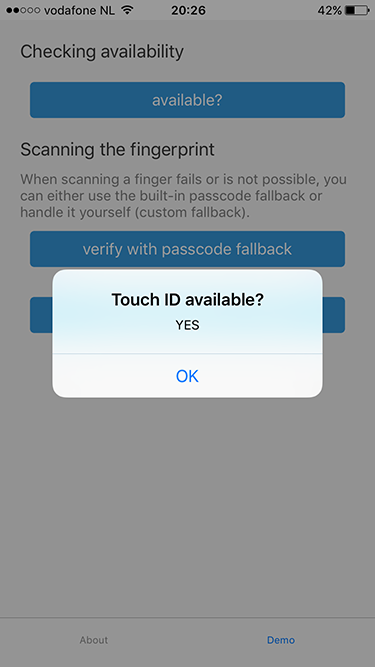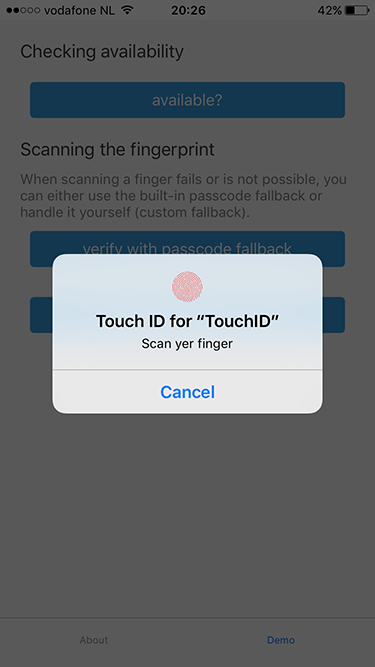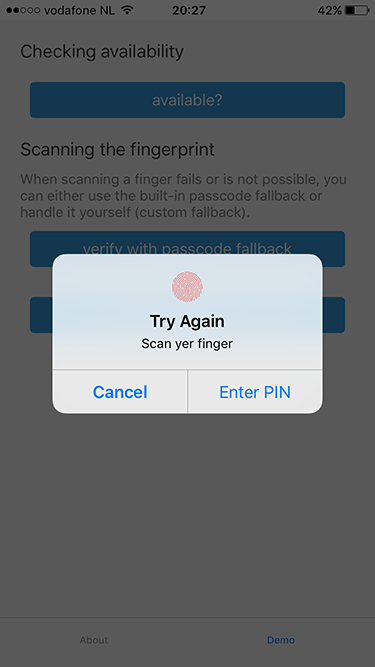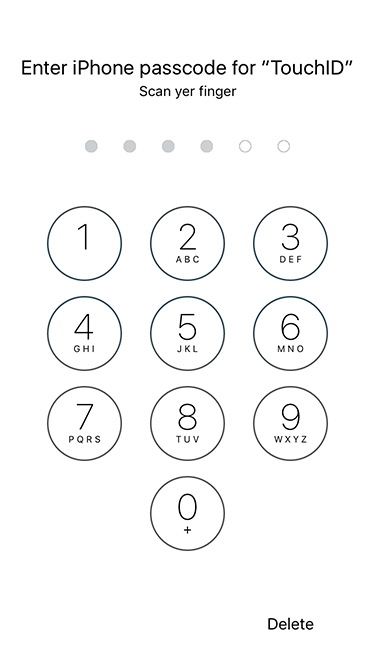NativeScript Fingerprint Authentication
Also works with Face ID on iPhone X 🚀
Requires Xcode 9+, iOS 11 SDK





Installation
From the command prompt go to your app's root folder and execute:
tns plugin add nativescript-fingerprint-auth
Demo
If you want a quickstart, check out the demo app.





API
Want a nicer guide than these raw code samples? Read Nic Raboy's blog post about this plugin.
available
JavaScript
var fingerprintAuthPlugin = require("nativescript-fingerprint-auth");
var fingerprintAuth = new fingerprintAuthPlugin.FingerprintAuth();
fingerprintAuth.available().then(
function(avail) {
console.log("Available? " + avail);
}
)
TypeScript
import { FingerprintAuth, BiometricIDAvailableResult } from "nativescript-fingerprint-auth";
class MyClass {
private fingerprintAuth: FingerprintAuth;
constructor() {
this.fingerprintAuth = new FingerprintAuth();
}
this.fingerprintAuth.available().then((result: BiometricIDAvailableResult) => {
console.log(`Biometric ID available? ${result.any}`);
console.log(`Touch? ${result.touch}`);
console.log(`Face? ${result.face}`);
});
}
verifyFingerprint
Note that on the iOS simulator this will just resolve().
fingerprintAuth.verifyFingerprint(
{
title: 'Android title',
message: 'Scan yer finger',
authenticationValidityDuration: 10,
useCustomAndroidUI: false
})
.then(() => console.log("Biometric ID OK"))
.catch(err => console.log(`Biometric ID NOT OK: ${JSON.stringify(err)}`));
A nicer UX/UI on Android (useCustomAndroidUI: true)
The default authentication screen on Android is a standalone screen that (depending on the exact Android version) looks kinda 'uninteresting'.
So with version 6.0.0 this plugin added the ability to override the default screen and offer an iOS popover style which you can activate by passing in useCustomAndroidUI: true in the function above.
Mandatory change
To be able to use this screen, a change to App_Resources/Android/AndroidManifest.xml is required as our NativeScript activity needs to extend AppCompatActivity (note that in the future this may become the default for NativeScript apps).
To do so, open the file and replace <activity android:name="com.tns.NativeScriptActivity" by <activity android:name="org.nativescript.fingerprintplugin.AppCompatActivity".
Note that if you forget this and set useCustomAndroidUI: true the plugin will reject the Promise with a relevant error message.
Optional change
If you want to override the default texts of this popover screen, then drop a file App_Resources/Android/values/strings.xml in your project and override the properties you like. See the demo app for an example.
verifyFingerprintWithCustomFallback (iOS only, falls back to verifyFingerprint on Android)
Instead of falling back to the default Passcode UI of iOS you can roll your own.
Just show that when the error callback is invoked.
fingerprintAuth.verifyFingerprintWithCustomFallback({
message: 'Scan yer finger',
fallbackMessage: 'Enter PIN',
authenticationValidityDuration: 10
}).then(
() => {
console.log("Fingerprint was OK");
},
error => {
console.log("Fingerprint NOT OK. Error code: " + error.code + ". Error message: " + error.message);
}
);
Face ID (iOS)
iOS 11 added support for Face ID and was first supported by the iPhone X.
The developer needs to provide a value for NSFaceIDUsageDescription, otherwise your app may crash.
You can provide this value (the reason for using Face ID) by adding something like this to app/App_Resources/ios/Info.plist:
<key>NSFaceIDUsageDescription</key>
<string>For easy authentication with our app.</string>
Security++ (iOS)
Since iOS9 it's possible to check whether or not the list of enrolled fingerprints changed since
the last time you checked it. It's recommended you add this check so you can counter hacker attacks
to your app. See this article for more details.
So instead of checking the fingerprint after available add another check.
In case didFingerprintDatabaseChange returns true you probably want to re-authenticate your user
before accepting valid fingerprints again.
fingerprintAuth.available().then(avail => {
if (!avail) {
return;
}
fingerprintAuth.didFingerprintDatabaseChange().then(changed => {
if (changed) {
} else {
}
});
});
Changelog
- 6.0.1 Fixed a compatibility issues with NativeScript 3.4.
- 6.0.0 Allow custom UI on Android.
- 5.0.0 Better
Face ID support. Breaking change, see the API for available.
- 4.0.1 Aligned with the official NativeScript plugin seed. Requires NativeScript 3.0.0+. Thanks, @angeltsvetkov!
- 4.0.0 Converted to TypeScript. Changed the error response type of
verifyFingerprintWithCustomFallback.
- 3.0.0 Android support added. Renamed
nativescript-touchid to nativescript-fingerprint-auth (sorry for any inconvenience!).
- 2.1.1 Xcode 8 compatibility - requires NativeScript 2.3.0+.
- 2.1.0 Added
didFingerprintDatabaseChange for enhanced security.
- 2.0.0 Added
verifyFingerprintWithCustomFallback, verifyFingerprint now falls back to the passcode.
- 1.2.0 You can now use the built-in passcode interface as fallback.
- 1.1.1 Added TypeScript definitions.
- 1.1.0 Added Android platform which will always return false for
touchid.available.












